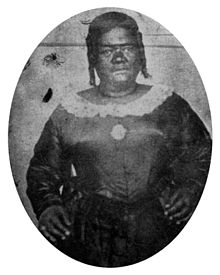Kekauōnohi
| Kekauʻōnohi | |||||
|---|---|---|---|---|---|
 |
|||||
| Born | c. 1805 Lahaina, Maui |
||||
| Died | June 2, 1851 Honolulu, Oʻahu |
||||
| Burial | June 30, 1851 Mokuʻula then Waineʻe Cemetery |
||||
| Spouse |
Kamehameha II (as Queen) Kahalaiʻa Luanuʻu Kealiʻiahonui Levi Haʻalelea |
||||
| Issue | William Pitt Kīnaʻu II Abigail Maheha (hānai) Mary Ann Kiliwehi (hānai) Anna Kaiʻulani (hānai) |
||||
|
|||||
| House | House of Kamehameha | ||||
| Father | Kahōʻanokū Kīnaʻu | ||||
| Mother | Kahakuhaʻakoi Wahinepio | ||||
| Full name | |
|---|---|
| Miriam or Mikahela Keahikuni Kekauʻōnohi |
Keahikuni Kekauʻōnohi (c. 1805–1851) was a Hawaiian high chiefess who was a member of the House of Kamehameha. She was granddaughter to King Kamehameha I and one of the wives of Kamehameha II. Her Christian name is disputed; it is given as Mikahela in the 1848 Mahele Book and as Miriam in later sources.
She was born circa 1805 at Lahaina, Maui. Her father was Kahōʻanokū Kīnaʻu. Her mother was Kahakuhaʻakoi Wahinepio, sister of Boki and Kalanimoku and granddaughter of Aliʻi Nui, Kekaulike of Maui. Her father was a son of Kamehameha I and his wife Peleuli, daughter of Kamanawa, one of the royal twins.
She married her uncle Kamehameha II. She was one of his five wives. Others were Kamāmalu, Pauahi, Kīnaʻu, and Kekāuluohi. She was the youngest, but Kamāmalu was Liholiho's favorite. She was at the famous meal when the kapu system was overturned in 1819, known as the ʻAi Noa. After Liholiho's death in London, she went to Kauaʻi to live with her half-brother Kahalaiʻa Luanuʻu, who served as governor of Kauaʻi from 1824 to 1825.
Kekauʻōnohi served as a governor of the island of Kauaʻi some time around 1840–1845 and was a stanch Protestant. Kamehameha III created the House of Nobles in the Hawaiian Constitution of 1840. She was among the first members along with the King, Hoapiliwahine, Pākī, Kōnia, Keohokalole, Kuakini, Kahekili, Leleiohoku I, Kekuanaoa, Kealiʻiahonui, Kanaʻina, Keoni ʻĪʻī, Keoni Ana, and Haʻalilio.
...
Wikipedia
